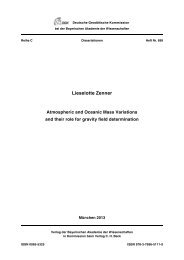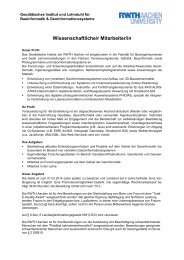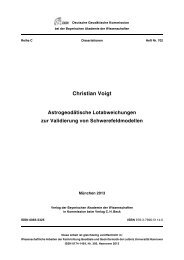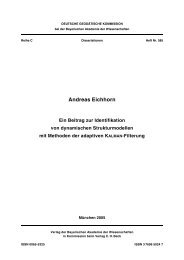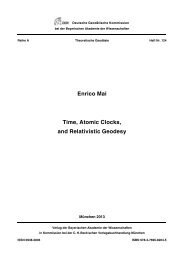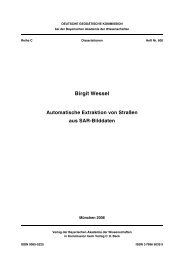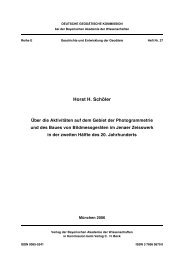vii berichte von fachinstituten an universitäten und technischen
vii berichte von fachinstituten an universitäten und technischen
vii berichte von fachinstituten an universitäten und technischen
Erfolgreiche ePaper selbst erstellen
Machen Sie aus Ihren PDF Publikationen ein blätterbares Flipbook mit unserer einzigartigen Google optimierten e-Paper Software.
364 Fachinstitute <strong>an</strong> Universitäten <strong>und</strong> Hochschulen<br />
Teaching activities at the Institute of Geodesy <strong>an</strong>d Navigation<br />
The study concept in the field of navigation follows more<br />
or less two interdependent lines: Signal processing <strong>an</strong>d<br />
navigation more strictly speaking. Signal processing starts<br />
in the 6. trimester <strong>an</strong>d navigation one trimester later. Signal<br />
processing I+II <strong>an</strong>d navigation I+II is m<strong>an</strong>datory for every<br />
student, whereas signal processing III <strong>an</strong>d navigation III<br />
cover more adv<strong>an</strong>ced topics <strong>an</strong>d belong to the area of<br />
specialization. In total the students have the choice among<br />
four topics of specialization in the study course of geoinformation<br />
<strong>an</strong>d geodesy.<br />
Dual line education concept<br />
Signal processing is considered as a series of lectures in<br />
order to provide f<strong>und</strong>amental knowledge for navigation.<br />
These lectures have the goal to lead the students to a<br />
sufficient <strong>und</strong>erst<strong>an</strong>ding of signal processing in GPS<br />
receivers <strong>an</strong>d INS systems <strong>an</strong>d of the Kalm<strong>an</strong> filter. In detail<br />
the topics of the signal processing lectures may be<br />
summarized as follows:<br />
– Introduction <strong>an</strong>d f<strong>und</strong>amentals<br />
– Analog <strong>an</strong>d digital signals<br />
– Sampling <strong>an</strong>d qu<strong>an</strong>tization<br />
– Dynamic systems <strong>an</strong>d stochastic processes<br />
– Basics of control theory<br />
– Kalm<strong>an</strong> filtering<br />
– Signal processing for GNSS receivers<br />
– Signal processing for INS algorithms<br />
The lectures in navigation are based step-by-step on the<br />
lectures in signal processing. The effort <strong>und</strong>ertaken in the<br />
navigation lectures is to give the students <strong>an</strong> introduction<br />
to the state-of-the-art in modern navigation, i.e. with the<br />
emphasis on satellite <strong>an</strong>d inertial navigation <strong>an</strong>d sensor<br />
integration. These fields are complemented by lecture<br />
material about classical navigation, e.g. about OMEGA,<br />
LORAN-C, VOR/DME. In detail the following contents are<br />
presented in the navigation lectures:<br />
– Introduction <strong>an</strong>d history of navigation<br />
– F<strong>und</strong>amentals, e.g. electromagnetic waves<br />
– Dead-reckoning systems (car, aircraft, ship)<br />
– Inertial navigation (gyros, accelerometers)<br />
– Satellite navigation (Tr<strong>an</strong>sit, GPS, GLONASS,<br />
GALILEO, WAAS, EGNOS, LAAS)<br />
– GPS modernization <strong>an</strong>d military GPS<br />
– Gro<strong>und</strong> based methods (LORAN, OMEGA, VOR/DME,<br />
TACAN, ILS, MLS )<br />
– Integrated systems<br />
– Special topics (high-sensitivity GPS, GPS/INS coupling,<br />
multipath, mobile communications)<br />
– Applications (l<strong>an</strong>d, maritime, air, space)<br />
All the lectures are supplemented by computational <strong>an</strong>d<br />
instrumental exercises <strong>an</strong>d field demonstrations. For the<br />
latter we make use of the earlier described facilities of the<br />
institute. The philosophy of the educational approach is on<br />
the one h<strong>an</strong>d that the students should learn <strong>an</strong> appropriate<br />
level of theory of navigation. This me<strong>an</strong>s that we require<br />
that e.g. every student should have performed <strong>an</strong> absolute<br />
<strong>an</strong>d differential GPS positioning solution in MATLAB or<br />
C programming l<strong>an</strong>guage based on real data. Another<br />
import<strong>an</strong>t topic of this kind is the implementation <strong>an</strong>d<br />
simulation of the dynamic error state equations of <strong>an</strong> INS<br />
on the PC, including simplified forms of the Kalm<strong>an</strong> filter<br />
(single axis INS with position, velocity <strong>an</strong>d/or attitude<br />
up-date). On the other h<strong>an</strong>d we think that it is necessary that<br />
students also get a basic practical impression of how to<br />
operate navigation instruments like a GPS receiver (low-end<br />
to high-end), <strong>an</strong> inertial navigation system or a LORAN-C<br />
receiver.<br />
Research<br />
With respect to Europe<strong>an</strong> st<strong>an</strong>dards the Institute of Geodesy<br />
<strong>an</strong>d Navigation is very committed to research in navigation.<br />
This is also confirmed by the fact that about 75% of the staff<br />
(research associates) are paid by externally f<strong>und</strong>ed research<br />
projects, which me<strong>an</strong>s that the institute has to acquire<br />
research contracts of the order of 1.0 Million € per year. A<br />
failure in this acquisition process would immediately result<br />
in a reduction of staff members.<br />
Research History<br />
The institute has carried out research for almost 20 years<br />
now <strong>an</strong>d has been able to provide signific<strong>an</strong>t contributions<br />
to science <strong>an</strong>d technology in the fields of geodesy <strong>an</strong>d<br />
navigation. For inst<strong>an</strong>ce, the concept of Operational Geodesy<br />
(”Integrated Geodesy”) was developed <strong>an</strong>d optimized<br />
in the early days after the fo<strong>und</strong>ation of the institute resulting<br />
in the integrated software package OPERA. High<br />
precision inertial navigation <strong>an</strong>d GPS/INS integration as<br />
well as pseudolite research have been <strong>an</strong>d still are import<strong>an</strong>t<br />
research foci. Several software packages were written for<br />
major GPS m<strong>an</strong>ufacturers which are now in world-wide use.<br />
Already in the late 80’s orbit determination of GPS satellites<br />
was investigated <strong>an</strong>d GPS orbit parameter estimation was<br />
introduced into high precision GPS baseline vector<br />
estimation software, like e.g. TOPAS (now well-known as<br />
the enh<strong>an</strong>ced product GeoGenius followed up by Trimble<br />
Total Control).<br />
Current Research Topics<br />
The Institute has the four major working groups, namely<br />
"GALILEO <strong>an</strong>d GNSS-2", "Sensor Fusion <strong>an</strong>d Integration",<br />
"GNSS Software Receiver" <strong>an</strong>d "Other Projects". These<br />
groups have been set up according to the current research




